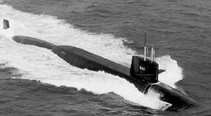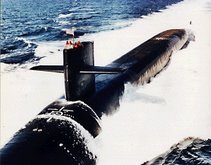In the October issue of Proceedings magazine author Norman Polmar writes in his article "Strategic Submarine Progress" (not currently available on-line) about some unconventional thinking relating to Submarine Launched Ballistic Missiles or SLBMs.

Trident II D5 Missile (Source: US Navy)
The unconventional thinking is put forth by the Defense Science Board and it is to arm some SLBMs with conventional (non-nuclear) warheads. The proposal pertains to the converted Trident SSGNs and recommends retaining some SLBM capacity. Rear Admiral Charles B. Young, Director of Strategic Systems Programs was quoted in Aerospace Daily & Defense Report, 17 June 2005 as saying a SLBM could deliver 1,250 pounds of conventional explosive to a range of 1,500 nautical miles, adding "Time of flight would be about 14 to 15 minutes... So if you have a time-critical target, that is a great capability".
The idea is that a conventional warhead's accuracy could also be enhanced to less than 30 feet with the addition of a global positioning system GPS guidance package. There is also some speculation in Polmar's Proceeding article that if the Navy were to pursue a conventional-warhead Trident missile they may consider arming Trident SSBNs in addition to or instead of SSGNs.
Although I don't think such a proposal would be very cost effective, placing a 1000 lb bomb on a extremely expensive weapons system, it does have its merits. (Addition reading on merits at the Baker Institute in pdf)
First being the ability to place a conventional weapon on a time-critical target from an extreme range. This would give the defense department a quick reaction option to an unanticipated region or situation where other assets could be hours if not days away. The caveat here being that if the target is unanticipated how do you quickly and accurately communicate the targeting information to the submarine submerged and maybe 1500 nautical miles away.
A second benefit could be the shock and awe factor. A dictator or terrorist may feel the remoteness of his location or no clear nearby US military presents as a form of safety until his chemical weapons pilot-plant is destroyed by a warhead falling at something close to Mach in double digits. The kinetic energy release alone could scare the hell out someone standing within visual range. Additionally placing the idea in the head of a dictator that the next warhead could be in the kiloton range may be enough to instill a little behavior modification to the positive.
Third, the capability to deliver a conventional weapon from a great distance with extreme accuracy and within minutes could force hostile nations to either harden or decentralize their high value military assets. The tactic of hardening, hiding or building decentralized redundancy would be costly to a potential enemy and may result in reduced command and control of those assets. The only other option for them would be to build or buy an Anti Ballistic Missile (ABM) system. This could also draw funds and skilled personnel away from the offensive weapons systems that we are more concerned about.
Lastly, the conventional SLBM warhead could be a way of prototyping and testing technology and designs to be later adapted for nuclear warheads. Such technologies could include the aforementioned improved accuracy with GPS as well as bunker busting earth penetrating munitions.
Apart from the cost, numbers of conventionally armed SLBMs would be limited because it would compete with the traditional SSBN role. A SLBM with a conventional warhead would also not be an option where an adversary is a known nuclear power with ICBM and or SLBM capability. A conventional strike could be mistaken for a nuclear one and invoke a nuclear response. Additionally such a weapon would complicate any future arms limitation talks with said powers.
The Navy has rejected this idea in the past but with the advent of the Trident conversions to SSGNs the concept may be given another look.
Video link for Missile one away, Missile two away (mpg 4.1mg).....









4 comments:
PBS, good points and probably the reason the Navy has never followed through with the concept of a conventionally armed SLBM in the past, too politically difficult. Although I think an SSGN 154 TLAM salvo would also be a little unnerving to those same nuclear nations. How could they know that the TLAMs weren’t carrying tactical nukes?
When it comes to SALT I/II/III? as Ronald Reagan would say to Mikhail Gorbachev “trust and verify”. I’m guessing you would have to prevent mixing apples and oranges or “mushrooms and daisy cutters” if you like. Defiantly something, the policy makers would have to smooth out with our “friends” in on the other side of the world.
MT1(SS), Emergency Action Message EAM, makes sense they would use a proven comm. method. The question or caveat I should have posed was how quickly actionable intelligence could be translated into a retargeting package, thinking it through, probably pretty quick. The example that comes to mind is the B1 strike on the downtown Baghdad restaurant to get Saddam Hussein during the Iraq war. From what I understand they just missed Saddam that day. Nevertheless, the covert intel asset was able get the air strike within 30 minutes or so of spotting Saddam and sending the GPS data. Accurate Intel, reaction time and time to target all become extremely important when trying to close the loop and get a precision weapon to target.
I've also read that a similar conventional warhead ballistic missile system was at one time being looked at for Attack Subs VLS tubes.
Just like bringing back diesel boats, the conventionally armed ballistic missile keeps returning (both ICBMs and SLBMs). I haven’t kept track of the issues for 3 years, and may be missing a few details, but here are a few more pros, cons, and details to think about.
- The START (I) Treaty matters. START II does not (dead). The Strategic Offensive Treaty (Moscow Treaty) is also germane. The SSGNs already count against the START (the tubes matter, not the missiles/warheads) as a Trident I (C4); however, START is a 15-year treaty and could expire Dec 2009 (or could be extended).
- This is a very expensive way to send a delivery, though this could be seen as a sunk cost. Per the Navy website, a Trident II (D5) missile costs $31M each (would cost much more now).
- Agreements with Russia require advance notification of any ballistic missile launch.
- SSGN - Decision time on this was several years ago, before the tube liners, gas generators, etc. were pulled. Putting SLBMs back on would be very expensive.
- SSBNs – Easy to make a few missiles conventional, but putting a SSBN the stated 1500nm away from the target could be problematic, likely taking it far away from normal patrol areas (thereby taking its nuclear missile offline). Equally problematic is where the first and second stage rocket motors would fall. This is the biggest problem with using a conventional ICBM (without relocating to a coast) – raining down a big chunk of metal onto someone’s home. In the case of the SLBM, possibly having the pieces land on a third country (act of war?).
- The kinetic energy would be the primary destruction method. The speed of an incoming reentry body is much in excess of the stated “something close to Mach in double digits.” Think meteor. Related to this, the GPS guidance would be used before reentry into the atmosphere, as afterwards the atmospheric plasma around the reentry body would prevent decent radio reception (think of the radio blackout during reentry of the Apollo spacecraft).
Bottom line, too expensive to retrofit onto the SSGNs. Possibility on SSBNs. This could be a silver bullet, available but not always ready where you need it. RG
RG, Excellent comments, thanks for tying up some of the loose ends in my post.
I agree SSGNs are probably not going have this capability, at least not with a D5 missile; lead time for planning and design is past.
Good point having a SSBN with two sets of missile ranges the conventional requiring a heaver payload and therefore shorter range. Per positioning to a patrol area would require an educated guess the mix of threats. In some cases the mix could work, such as North Korea for the Conventional and others further west for the Nuclear. However, this would make for some very nervous neighbors when the launch of the conventional goes suborbital.
A silver bullet is a good way of putting it. Expensive and very few available with an added political risk of misinterpret intentions or targeting.
Post a Comment